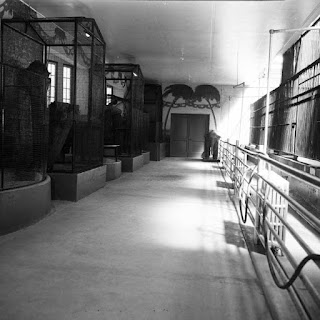 |
| Postcard of Shasta the Liger at Hogle Zoo, 1950s. |
Shasta was the first liger born in the US and holds the world record for being the longest-lived liger ever known. She was born at Hogle Zoo on May 6 1948 to an African Lion father (named Huey) and a Bengal Tiger mother (named Daisy). If Shasta had been born to a lion mother and a tiger father, she would have been a Tigon, one of which was at the NYC Central Park Zoo at the time of Shasta’s birth.
At the time of Shasta’s birth, zoos operated akin to a circus in that animals were used to attract visitors and they paid little attention to conservation or animal ethics.
Thus, Hogle Zoo officials encouraged the mating of a lion and a tiger to produce a hybrid, one not normally found in nature. Shasta’s parents were introduced to each other by first placing their cages next to each other and then by allowing them to be in the same cage for the duration of the mating season and were relieved when one did not kill the other. Zoo employee Joe M Naylor, who was likely responsible for the mating, later boasted that only he knew the secret “love potion” to making hybrids.
When Shasta was born in 1948, she was ignored by her mother so Superintendent of City Parks and top boss of Hogle Zoo, Joseph Sloan, took Shasta home for his wife Bertha to care for. As the Superintendent, the Sloans were provided city housing- the historic Isaac Chase house which now serves as the Chase Home Museum of Utah Folk Arts within Liberty Park.
Bertha took on primary care of Shasta for the first few months of her life. Shasta was doted upon by Bertha and a running joke of zoo employees was that she was named after her temperament in that “she hasta have this, and she hasta have that.” In reality, Shasta was named by a contest held by the Salt Lake Telegram.
Shasta was bottle-fed with a custom mix of milk formula, lime water, vitamins, egg, and cod liver oil and was burped like a baby when she needed it. She played in the house and after a couple of months, she was allowed to play outside on the lawn of Liberty Park (Image 2-3). Shasta’s favorite toy was an old leather purse of Berthas which Shasta pounced, chewed, and wrestled with. As she grew Shasta was moved to the upper porch of the Chase house where she could roam a little more freely.
Shasta’s first few months were also her most famous with photographs of her published in newspapers around the world. Life Magazine even did a 4-page spread on Shasta in Sept 1948 (Image 4).
 |
The first page of the 4-page Life Magazine article on Shasta, Sept 20 1948.
|
Shasta moved back to Hogle Zoo when she was about 3 months old and for the duration of her 24-year life, she was the most popular animal at the zoo. She had birthday celebrations every year in which thousands of people would visit her (Images 5-6).
Most of Shasta’s life was spent in the now-demolished Old Lion House building where the small animal exhibit is currently located. This facility was little more than metal cages within a concrete building with dividers separating Shasta from the other big cat species (Images7-8).
 |
| Sasta in her enclosure in the now-demolished old Lion House, March 1949 “Shasta the Liger - 19” From UDSH |
 |
| Shasta in her enclosure in the now-demolished old Lion House, May 4 1949 “Shasta the Liger - 23” From UDSH |
In 1970 the new Feline Building was completed (now remodeled into the Cat Wok Café) and Shasta and the other big cats were moved into the larger facilities. Shasta had never seen a lion or a tiger in her entire life and she cowered in the corner of her new enclosure for several days.
Shasta died in 1972 at the age of 24 years. Since Shasta was so loved and a major attraction, zoo officials decided to have her stuffed and return to the zoo for exhibit. In 1997 Shasta was moved to the Monte L Bean Life Science Museum at BYU because hybrids in zoo setting had become controversial.
You can still visit Shasta at BYU (Image 8).
 |
| Shasta at the Monte L Bean Museum, 2022 |
Sources:
Salt Lake Telegram 1948-05-06
Salt Lake Telegram 1948-07-28
Life Magazine 1948-09-20
Deseret News 1970-03-18
Deseret News 1970-05-07
Deseret News 1972-07-19
Davis County Clipper 1972-08-04
Salt Lake Tribune 1977-12-25
Salt Lake Tribune 2016-06-20


















































